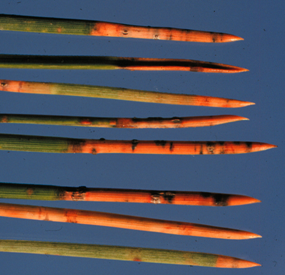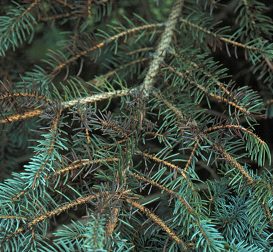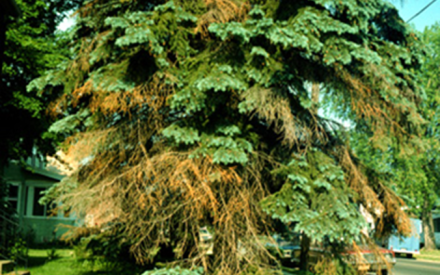
What is Phomopsis tip blight?
Phomopsis tip blight is one of the most common fungal diseases of conifers in Wisconsin. It is most severely affects junipers (e.g., Eastern red cedar, creeping and Rocky Mountain junipers) but can also cause issues on arborvitae, Douglas-fir, true firs, larch, pines and spruces.
What does Phomopsis tip blight look like?
On junipers, small gray lesion (spots) first form on the terminal four to six inches of new shoots in early spring. Infected branches typically initially turn dull red or brown, and then ash-gray as lesions girdle and kill branch tips. Small, black pycnidia (the reproductive structures of the causal fungus) can easily be seen on dead branches with the unaided eye or with a hand lens. Severe infections may result in death of an entire juniper. Phomopsis tip blight rarely kills other conifer hosts, although branch dieback is a typical symptom.
Where does Phomopsis tip blight come from?
Phomopsis tip blight is caused by several fungi currently or formerly classified in the genus Phomopsis. These fungi survive in diseased and dead branches. Spores of these fungi are produced throughout the growing season, and are spread by wind and rain. Infections can occur whenever new foliage is produced, and moisture or humidity is high. Most infections occur in the spring, but late summer infections can occur if over-watering or over-fertilization stimulates new growth.
How do I save a juniper with Phomopsis tip blight?
Prune out and destroy diseased branches as they appear. Always prune in dry weather, and cut four to six inches below obviously diseased areas on each branch. Decontaminate pruning tools after each cut by treating them for at least 30 seconds with a 10% bleach solution or (preferably due to its less corrosive properties) 70% alcohol (e.g., rubbing alcohol or certain spray disinfectants). For particularly susceptible junipers, combine pruning with use of copper or mancozeb-containing fungicides. Make applications at seven to 21 day intervals during rapid growth in the spring. Be sure to read and follow all label instructions of the fungicide that you select to ensure that you use the product in the safest and most effective manner possible.
How do I avoid problems with Phomopsis tip blight in the future?
Plant only resistant juniper species, varieties, and cultivars. DO NOT plant conifers in poorly drained sites or heavily shaded areas. DO NOT overcrowd trees and shrubs in new plantings. Provide adequate space between plants to promote good air circulation and rapid drying of foliage. DO NOT prune or shear conifers excessively as this stimulates excessive new, susceptible growth. If possible, DO NOT use overhead sprinklers for watering. Use a soaker or drip hose instead. If you must overhead water, water early in the day to allow for fast drying of plants.
For more information on Phomopsis tip blight:
Contact the University of Wisconsin Plant Disease Diagnostics Clinic (PDDC) at (608) 262-2863 or pddc@wisc.edu.
Authors: Gina Foreman* and Brian Hudelson, UW-Madison Plant Pathology
Last Revised: 03/01/2024
D-number: D0077
*Completed as partial fulfillment of the requirements for Plant Pathology 875 – Plant Disease Diagnostics Clinic Internship at the University of Wisconsin Madison.
References to pesticide products in this publication are for your convenience and are not an endorsement or criticism of one product over similar products. You are responsible for using pesticides according to the manufacturer’s current label directions. Follow directions exactly to protect the environment and people from pesticide exposure. Failure to do so violates the law.
Thanks to Karen Delahaut, Lis Friemoth and Ann Joy for reviewing this document.
A complete inventory of UW Plant Disease Facts is available at the University of Wisconsin-Madison Plant Disease Diagnostics Clinic website: https://pddc.wisc.edu.
Send a Plant Sample for Analysis
Be cautious when self-diagnosing plant health issues. Very few diseases can accurately be diagnosed by eye.
Contact the UW Plant Disease Diagnostics Clinic (PDDC), and for a small fee, clinic staff can examine a plant, determine the cause of the disease/disorder, and provide advice on how to control or prevent the issue.
Download Article





 Conifer Disease Quick Reference
Conifer Disease Quick Reference Dothistroma Needle Blight
Dothistroma Needle Blight Rhizosphaera Needle Cast
Rhizosphaera Needle Cast Cytospora Canker
Cytospora Canker


